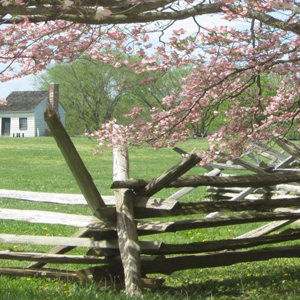Landscape Information
Enclosed by the Appalachian and Allegheny Plateaus to the west and the Blue Ridge to the east, this plantation was established by German immigrant Jost Hite in 1732. Hite and several other families settled a land grant totaling 140,000-acres situated in the agriculturally rich Shenandoah Valley. In 1783, 483 acres was passed to its founder’s grandson Major Isaac Hite and his wife Nelly—President James Madison’s sister—and the two commissioned a manor house to be constructed. Built of limestone quarried nearby, the Classical Revival house served as the center of what would grow into a 7,500-acre plantation tended by more than 100 enslaved. Hite died in 1836 and in 1860 the plantation was sold out of the family and slowly subdivided.
Occupied by Union General Philip Sheridan, the house and its landscape served as a headquarters during the Civil War. Figuring prominently in the Battle of Cedar Creek in 1864, the bluffs surrounding the property were embellished with a winding defensive network of ditches and reinforced earthworks. As this battle marked the end of Confederate occupancy of the Shenandoah Valley, the property saw a succession of owners and was eventually purchased by the preservation-minded Hunnewell family in 1929. In 1964 the house was bequeathed to the National Trust for Historic Preservation and, along with an ice house, smoke house, orchard, and cemetery, was opened to the public three years later. Designated a National Historic Landmark in 1969, Garden Club of Virginia landscape architect Rudy Favretti designed a historically accurate demonstration cutting garden adjacent to the house in 1986. The 383-acre Belle Grove Plantation operates as a working farm in the 2,500-acre Cedar Creek and Belle Grove National Historical Park designated in 2002 .




